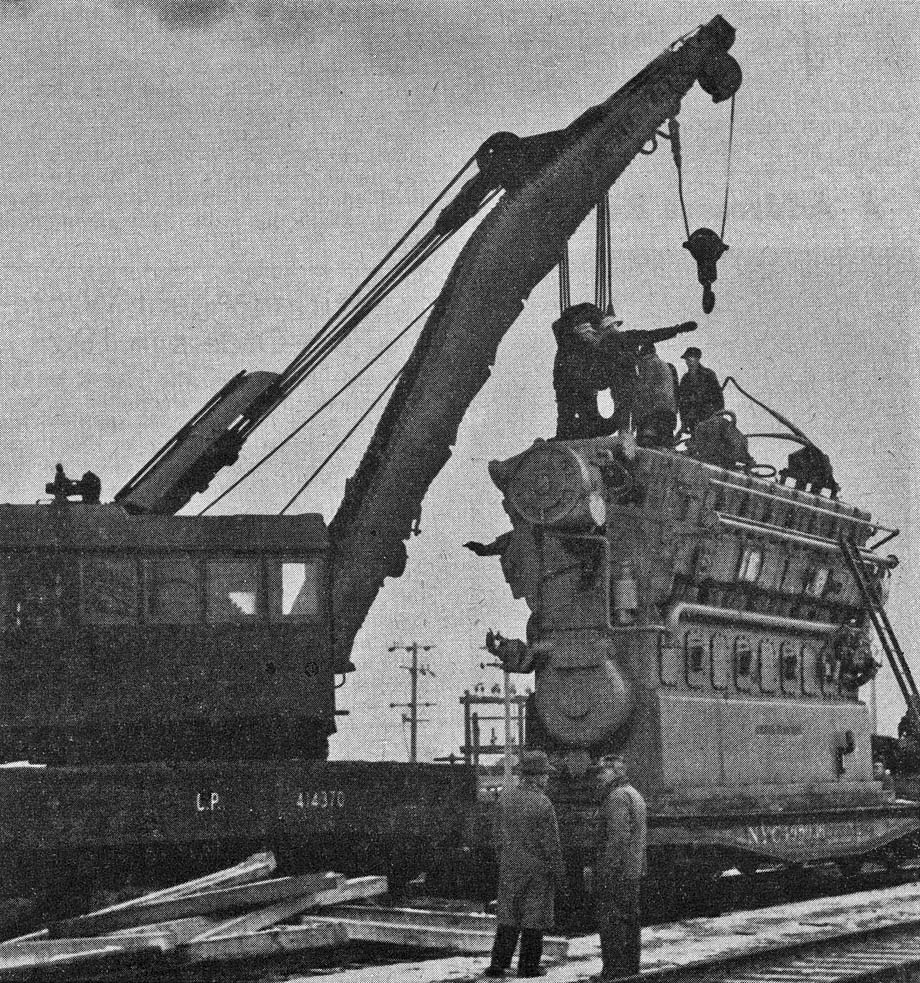

100-Ton Stationary Diesel Engine Constitutes Heaviest "Lift" Ever Handled by C.P.R.
A 100-TON stationary diesel engine, which travelled over the Company's line from Grove City, Pennsylvania, to Kamloops, B.C., was unloaded at the interior B.C. city recently following one of the heaviest "lifts" ever experienced by the Company, in the west at least. The engine built by Cooper-Bessemer, was delivered to the British Columbia Power Commission's generating plant at Kamloops, and will be used as a stand-by electric power generator.
Freight and operating departments worked in close harmony planning infinite details for handling and unloading of the giant shipment. Considerable advance paper work by Canadian Pacific people, and by experts from Simson-Maxwell Ltd., Vancouver, who sold the engine, paved the way for the skilled work which began at approximately half-past seven in the morning, and which was completed at four o'clock the same afternoon. W.R. McCusker, travelling freight agent, Vancouver, was overseer for the freight department.
To the novice it, would have appeared to be a simple matter for the huge 150-ton crane to shift the huge freight shipment from its flatcar to the ground at the side of the track in a relatively short time. But the novice would have failed to take into account the precautions necessary to ensure the safe and intact delivery of the $300,000, 16-cylinder engine to its owners.
Teamwork which attended the big "lift" was most impressive. From the time the outrigging of the heavy crane was shored and shimmed, and the "big hook" made its first contact with the diesel engine, until after the job had been completed, every man of a crew approximating 20, knew his responsibility. One, for instance, directed keen, watchful eyes to the wheels of the crane, to warn others if and when the crane's wheels raised from the track.
Another kept vigil over the stout wire rope cables which bore the 100-ton weight, to observe any possible "stranding". Stranding of the cable could cause unravelling, it was pointed out, and threaten collapse, with consequent disastrous results to the load. Coupled with these precautions, the ground crew constantly erected platforms of ties beneath the load, to take up the slack between ground and machine, in case anything happened.
But nothing happened.
The mammoth engine was deposited easily, and without incident on track-side metal skids, and was later moved into the generating plant.
C.W. Powles, division master mechanic, Vancouver, who helped supervise the unloading, said that it was one of the largest rail-freight shipments ever handled by the Company, and he, together with shipping representatives who received the engine, had high praise for the manner in which the delivery and unloading were accomplished.
 Railway Limited and is reprinted here with their permission. All photographs, logos, and
trademarks are the property of the Canadian Pacific Railway Company.
Railway Limited and is reprinted here with their permission. All photographs, logos, and
trademarks are the property of the Canadian Pacific Railway Company.
